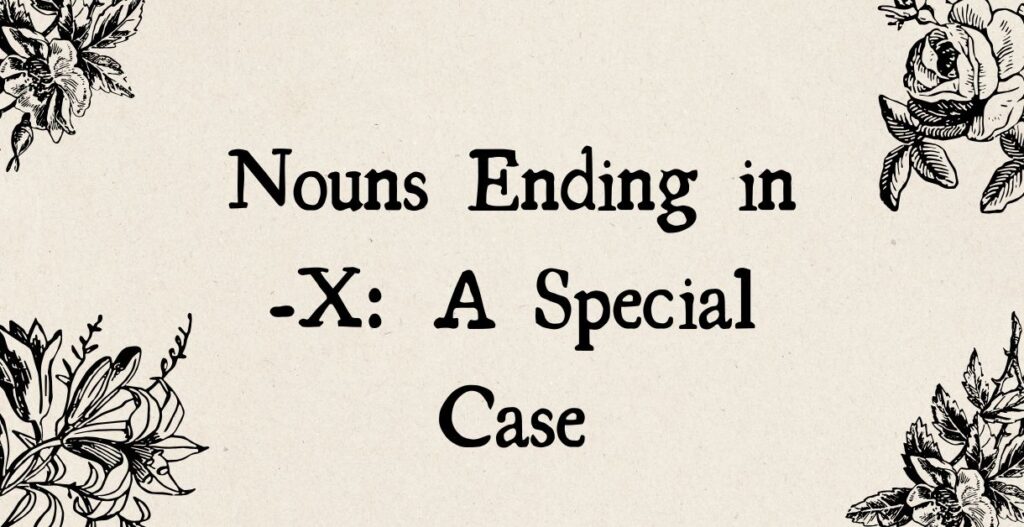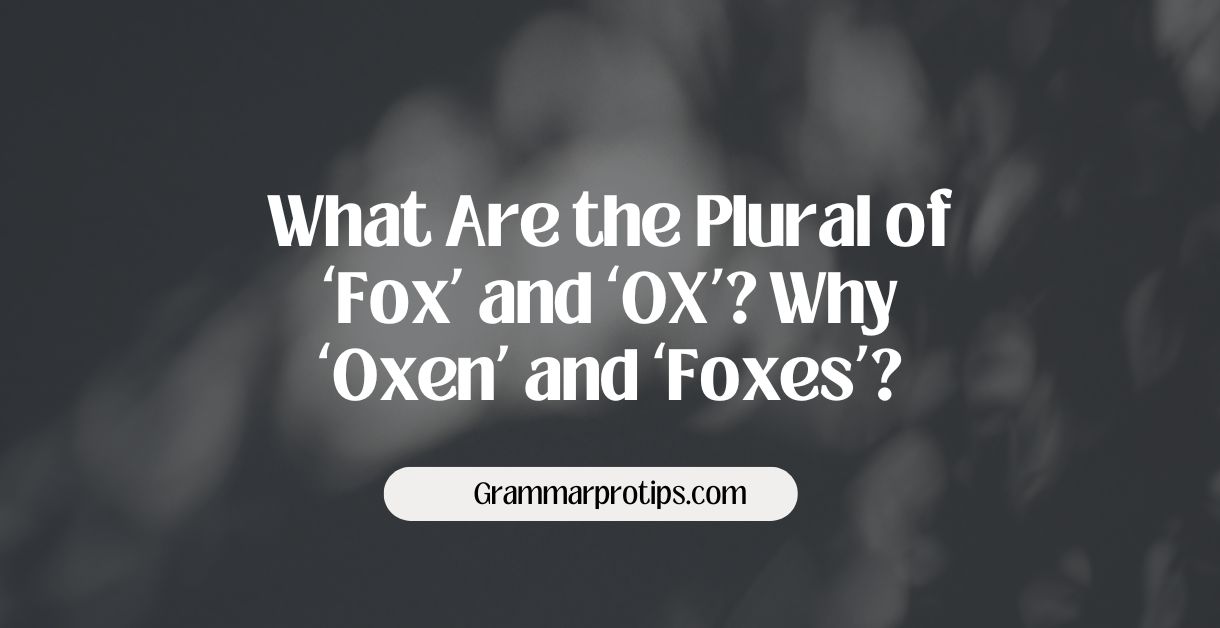English, with its rich history and peculiarities, can sometimes feel like a labyrinth of rules and exceptions, especially when it comes to pluralization. For many learners and even native speakers, the question of what the plural of fox and ox is can be puzzling.
Why is the plural of ‘ox’ “oxen,” and why do we say “foxes” instead of “foxen”? These questions delve into both the evolution of English and the fascinating quirks of pluralization. In this article, we’ll unravel these mysteries, using real-world examples to help clarify these commonly misunderstood terms.
Pluralization Rules in English: An Overview
Before we get into the specifics of plural of ox and fox, it’s essential to understand the basics of pluralization in English. English typically forms plurals by adding -s or -es to the singular form of a noun. For example, cat becomes cats, and dog becomes dogs. However, things aren’t always so straightforward. The plural of ox and fox break these rules, so let’s explore why these two words are outliers.
Regular vs. Irregular Plurals
In general, English grammar rules for pluralization follow regular patterns. The most common suffix used to form plurals is -s. Yet, English has its fair share of irregular plurals, words that don’t follow the regular rules. Both fox and ox fall under this category.
For example:
- Regular plural: book → books
- Irregular plural: tooth → teeth
Why Ox Plural is Oxen

Let’s start with the plural of ox. The plural form of ox is not oxes but oxen. This irregularity dates back to the Old English plural forms, where words ending in -x had a special pluralization rule. In Old English, nouns that referred to animals often followed a different pattern of pluralization compared to other nouns.
Historical Development of English: Why Ox Plural is Oxen
The word ox comes from the Old English word oxa, and its plural form was oxan. Over time, English underwent significant changes, especially in its vowel sounds and word endings. By the time Middle English emerged, the suffix -en was often added to certain animal-related nouns to form their plural, like bovine animals (oxen). This explains why the plural of ox became oxen.
To give you a clearer picture, imagine this scenario in a modern context:
Email Scenario:
Subject: Farm Animal Count Update
Hi Jessica,
I just wanted to update you on the number of animals we have for the upcoming auction. We have ten oxen and twelve cows ready for display. Could you please confirm that everything is set for these particular animals?
Best regards,
David
In this example, we see how oxen is used to refer to more than one ox, following the old pluralization rule.
What is the Plural of Fox?
Now let’s turn our attention to the plural of fox, which is straightforward in comparison to ox. The plural of fox is foxes. This follows the regular pluralization pattern of adding -es to nouns that end in -x. So, when talking about more than one fox, we simply add the -es suffix.
For example, imagine the following situation:
Email Scenario:
Subject: Wildlife Sighting Report
Dear Alan,
I wanted to let you know about a recent observation. During my hike yesterday, I spotted several foxes near the wooded area. They seemed to be hunting in groups, which I thought was interesting. I’ll send you some photos when I get the chance.
Best,
Sarah
Here, foxes is used to indicate the plural, following the standard rule for nouns ending in -x.
Why Don’t We Use ‘Foxen’?
You might wonder, if the plural of ox can be oxen, why isn’t the plural of fox foxen? It turns out that while Old English had the plural suffix -en for some animals, not all animal-related words followed that pattern. Over time, words like fox were adopted into Middle English and followed the simpler pluralization rule of adding -es. The result? Foxes rather than foxen.
Plural of Fox and Deer
The plural of fox is foxes, as we have already seen. But what about deer? The plural of deer is the same as its singular form—deer. This may seem odd because English usually adds -s to form the plural, but deer is an example of another irregular plural.
Imagine the following example:
Email Scenario:
Subject: Wildlife Preservation Update
Hello Thomas,
I just returned from the nature reserve. We spotted several deer grazing in the meadow. The rangers are concerned because we haven’t seen as many recently, and we need to keep track of their movements.
Regards,
Emily
Here, the plural of deer is the same as its singular form.
Nouns Ending in -X: A Special Case

Both fox and ox end in -x, which places them in a special category when it comes to pluralization. Nouns ending in -x generally follow specific rules, and although oxen may seem odd, it fits with the historical use of Old English plural suffixes. Most modern nouns ending in -x form their plurals with -es, as we see with foxes.
Irregular Plurals vs. Regular Plurals
Let’s take a quick look at some other irregular plurals to understand the differences between regular and irregular plurals:
| Singular | Plural |
|---|---|
| fox | foxes |
| ox | oxen |
| mouse | mice |
| tooth | teeth |
| goose | geese |
This table shows how irregular plurals don’t follow the typical -s or -es pattern. Instead, they change their internal structure or use different suffixes altogether.
English Language Peculiarities: Plural Forms of Animals
English is full of peculiarities when it comes to animal plurals. While foxes and oxen follow irregular patterns, many animal names follow regular pluralization rules. For example:
- dog → dogs
- cat → cats
- sheep → sheep
Interestingly, the plural of sheep is the same as its singular form. This is a carryover from Old English, where many animal names were uninflected in the plural form.
Plural of Mouse: Another Exception
Similar to oxen, the plural of mouse is mice. This follows a completely different pattern of irregular pluralization, as the word changes its internal structure.
Example:
Email Scenario:
Subject: Pest Control Update
Dear Karen,
I wanted to update you on our latest efforts to manage the rodent issue. We’ve noticed mice running around in the attic, and we’re bringing in the exterminators tomorrow to address the situation.
Best,
Matt
Rules for Pluralizing Nouns
Let’s review the key rules for pluralizing nouns:
- Regular Plurals: Add -s or -es for nouns that end in vowels or simple consonants.
- book → books, dog → dogs
- Nouns ending in -x, -ch, -sh, -s, or -z: Add -es to form the plural.
- fox → foxes, church → churches
- Irregular Plurals: These involve changing the word’s internal structure or using unique suffixes.
- ox → oxen, mouse → mice
- Unchanging Plurals: Some animal nouns do not change in the plural form.
- sheep → sheep, deer → deer
Conclusion
Understanding the plural of fox and ox requires diving into the rich history of the English language. Why ox plural is oxen traces back to Old English plural forms used primarily for bovine animals, while fox plural form in English follows the regular rule of adding -es. English is full of irregular plurals like mouse → mice and deer → deer, but these exceptions are what make English both fascinating and sometimes confusing.
Next time you find yourself wondering about the plural of foxes or oxen, you’ll know just how these terms evolved and why English grammar exceptions persist in the language. Whether you’re communicating in a formal email scenario or simply enjoying the quirks of the English language, understanding these irregular plural forms helps you navigate the world of animal plurals and English grammar rules with ease.

“Smith is the dedicated admin of [grammarprotips.com], a platform focused on enhancing grammar skills. With a passion for language and education, Smith strives to make grammar accessible and enjoyable for learners of all levels. Committed to delivering high-quality content, Smith continually explores innovative ways to help users master the complexities of grammar.”

